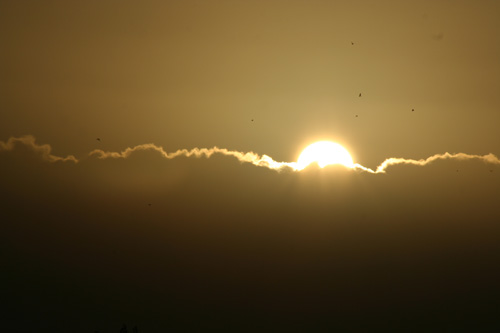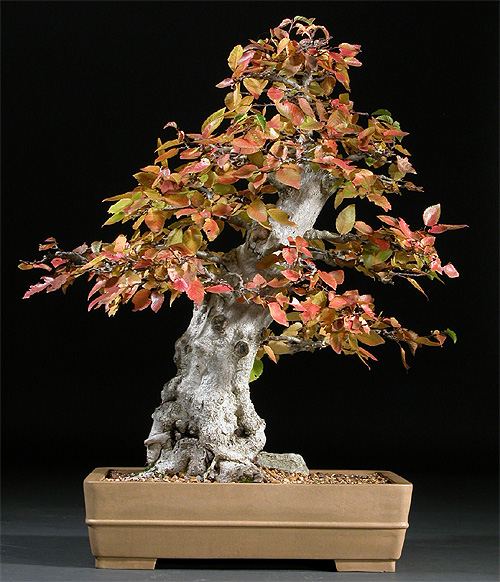
Both photos in this post are courtesy of Randy Clark of the Bonsai Learning Center.
More to come?
We just received the article below from Randy Clark of the Bonsai Learning Center in North Carolina on how to deal with the extreme heat that much of the country has been experiencing this summer. I may be a little late for those of us in the Northeast (at least here in northern Vermont), but for those of you further south, there may be more to come.
Summer in the Carolinas by Randy Clark
The Southeastern US is suffering from the heat wave this summer, although not as severely as is the rest of the nation. Nevertheless, temperature which are consistently in the plus 90 degree range present dangers to our bonsai which should not be ignored. Our trees do not enjoy these extended periods of sizzling temperatures any more than we do, but simply pouring buckets of water on them may not be the answer to the problem.
Most of our “temperate” bonsai grow most happily in a range that runs from about the mid to low 70’s through the mid to high 80’s. When temperatures exceed this range on either side, the tree begins to make biological changes in its systems designed to deal with these extremes. Winter dormancy is the reaction as temperatures fall toward the freezing range. Most of us are familiar with this seasonal change in our plants.
BUT… plants can also experience a period of “summer dormancy “when temperatures begin to climb into the 90’s. As the mercury begin to rise, the plants reacts by temporarily shutting down most of the growth systems and trying to conserve moisture. New growth comes to a halt and the stoma holes in the leaves close up so as to minimize the amount of moisture the plant is “exhaling” into the air.

This rugged old hornbeam appears on Bonsai Learning Center‘s home page.
When temperatures begin to fall back into the “optimal growing range,” these changes will reverse themselves and the bonsai will begin to grow again. YOU need to be aware that these changes may be taking place in your bonsai and deal with them accordingly. Here are a few tips to help your bonsai deal with the sizzling summer heat.
1. Inspect the moisture condition of the soil on each bonsai daily. If the plant is not using water, do not water it. Excessive moisture in the pot will only encourage root rot and other problems you don’t want.
2. Bonsai pots are ceramic and tend to heat up in the summer sunshine just like little furnaces. Purchase a misting nozzle for you hose and fog the pots and foliage. This will help the plant to cool down without running the danger of over drowning it.
3. Back off a little on the fertilization schedule, particularly if you are using a chemical form of high nitrogen fertilizers such as Miraclegrow or Hi-N-Pro. Pushing nitrogen at the tree will encourage new growth and that new tender growth will be incinerated by the summer sunshine.
4. Look at your trees and determine which ones are suffering the most from the heat. Pull back those specimens which are most delicate into more shade. It is better to have longer internode growth and larger leaves than to discover that you boiled you bonsai in the summer sunshine.
5. Avoid cutting and wiring you bonsai as much as possible until the heat begins to abate. The tree is under stress and your enthusiasm to create great art will not place any less stress on the tree.
6. Finally, when you do need to water, make sure the water coming out of the hose is not too extreme. A hose laying in the sun can contain scalding hot water and water that is too cold, can cause thermal shock to the plants roots.
These tips can be applied to most of your bonsai, but certainly not all of them. You may have noticed that the tropical trees really don’t seem to care how hot it gets. Here at the BLC our tropicals are having their best year ever. The spruces, maples, elms, hornbeams and others don’t seem to feel the same way about the weather. If you are getting a lot of yellow leaves on your bonsai, or experiencing a lot of leaf drop it can be a sign of over watering… or simply the trees way of dealing with the heat. Just remember that summertime is the most dangerous time of the year for bonsai in the Carolinas. Watch you plants closely. An ounce of prevention is worth a pound of cure.
And Now For The Commercial
If you are looking for ways to escape the summer heat, we might suggest a workshop in the air-conditioned comfort of The Bonsai Learning Center’s studio. We have a class on detailing and refining bonsai scheduled for September 18 and two classes for Beginner Basics set for September 25 as well as November 20. Openings are still available. You may also bring any plant material of you choosing to our Open Workshop set for October 16th. Full details about these programs are available at www.bonsailearningcenter.com or by calling us at 704-392-9244. Of course private “one-on-one” instruction is also always available.
I was very interested to read of your problems with the heat. Looking at photos of your trees it seems a lot of the time they are set up on their benches in the back yard. I have a small collection of trees and living in Australia we to have some high temps. My shade house was built before my house was finished. The frame is covered with shade cloth, the floor is mulched, the tap is also under the shade and is fitted with a retracting hose reel. I water once a day through the heat but not just the trees, a quick flick over the shade cloth and the mulch, (admittedly we are luckier than some that we don’t have the water restrictions that are in force in some places. My brother had to install a tank for his trees.) This also has two major advantages for me as well as my trees. Firstly it’s a lovely cool area to work on my trees. The second came as a bit of a surprise. I never seemed to have any problems with bugs, then I noticed that when rotating my trees I had to be extremely careful because frogs were under the pots enjoying the moisture and the cool. It wasn’t until I was late home one evening and watered by torch that I discovered that the frogs were paying their way, they were up in the trees debugging. Isn’t nature wonderful. Even my fertilising doesn’t bother them.
Thanks Greg,
Great story about the frogs.
Here in the eastern US things are a little different. We don’t have the consistently hot sun and dry air you most likely have. Lots of clouds and rain mixed in with some high humidity heat, makes shade covering less practical in most cases, especially with sun loving trees.
Out west in places like Arizona, parts of California etc, shade covers are often used.
A few tips for surviving a long hot dry summer with water restrictions. Tested in Melbourne, Australia.
1. Use every method possible to store rain water when it arrives. Big rubbish bins are good and cheap. I installed tanks to catch all rain water but these ran out during our ultra-hot summer two years ago when it got to 48 Celsius in my back garden on the hottest day.
2. Get some kitty litter trays, drill holes an even distance up all four sides, fill trays up to the level of the holes with non-clumping, natural kitty litter. Fill tray with water to the top of the kitty litter which will absorb the water but maintain a slightly moist atmosphere. Sit bonsai on top.
3. Cover the soil surface with wet hessian (sacking).
4. Make small bags, very loosely filled with water crystals (I used fine curtain material), soak and place on top of bonsai soil, covered with wet hessian.
5. Fill used soft drink bottles with water and up-end in larger bonsai. Putting a fine pin-hole in the base of the plastic bottle helps let air into the bottle so a vacuum does not form which slows down the water release.
6. Make sure your bonsai do not get the full afternoon sun. Move to the shade of trees/buildings for the duration of the hot spell.
7. Place bonsai on the ground in the shade.
Thanks Margaret. Good tips for those of you who suffer along in uninhabitable climates. Here in northern Vermont, summer temperatures seldom reach 32 (90F), and some summers barely reach 30 (86F). Sounds pretty good until you realize that summers only last about 10 minutes.
BTW: for us Americans still stuck on the nonsensical Fahrenheit system, 48 Celsius is 119F.